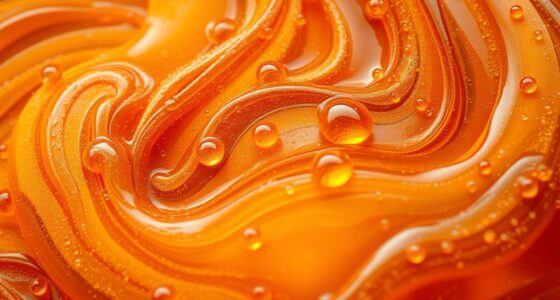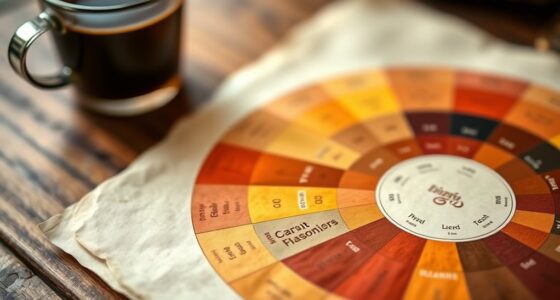Serving wine at the right temperature is key to releasing its full aroma potential. Too cold, and aromas become muted; too warm, and alcohol dominates, overshadowing delicate scents. Proper temperature enhances the wine’s vibrancy, while the right glass shape helps concentrate and direct aromas to your nose. Gently swirling the wine also boosts scent release. By understanding these principles, you’ll uncover richer aromas and a more enjoyable tasting experience—keep exploring to discover even more tips.
Key Takeaways
- Proper serving temperature enhances aroma vibrancy and prevents muted or overshadowed scents.
- Well-designed glasses direct and concentrate aromas toward the nose, improving perception.
- Combining correct temperature and glass shape optimizes aroma release and sensory experience.
- Gently swirling wine increases scent molecule release without disrupting aroma balance.
- Attention to serving temperature and glass selection reveals wine’s full complexity and character.

The temperature at which you serve a beverage considerably influences how its aroma is perceived. If you pour wine too cold, the aromas become muted, and you miss out on the full sensory experience. Conversely, serving it too warm can make the alcohol more prominent, overpowering the subtle scent notes that define its character. To truly enjoy the complex aromas, you need to pay attention to both temperature and presentation. The shape of your wine glass plays a vital role in aroma preservation. A well-designed glass directs the flow of wine to the parts of your mouth that best appreciate its flavors, but it also helps trap and concentrate the aromas. For example, glasses with a wider bowl allow the wine to breathe and release more of its scent, while narrower rims help focus the aroma toward your nose, intensifying your perception. Color accuracy also impacts the overall sensory experience, as accurate colors can influence your perception of aroma and flavor.
When you choose the right glass shape, you’re actively aiding aroma preservation. This means that even if the wine isn’t at its ideal temperature, the glass can compensate by concentrating the scent molecules close to your nose. This is especially important with delicate wines like Pinot Noir or Riesling, where aroma nuances are subtle and easily lost. Using the proper glass not only enhances aroma retention but also guarantees that each sip delivers a balanced sensory experience. When you serve wine at the correct temperature, around 55°F for reds and 45°F for whites, the aromas are more vibrant and expressive. The right glass shape complements this by preventing aromas from dissipating too quickly or becoming muddled.
You can further improve aroma preservation by gently swirling the wine in your glass, which releases more scent molecules into the air. Just remember that the effectiveness of this action depends on the glass’s shape—wider bowls give you more surface area to work with, amplifying this effect. Also, avoid overly aggressive swirling, which can cause the wine to cool or warm too quickly, disrupting its aromatic balance. Maintaining proper serving temperatures and choosing the right glass shape work hand-in-hand to optimize aroma release. This not only enhances your enjoyment but also allows you to appreciate the wine’s full complexity. When you pay attention to these details, you set the stage for a richer, more engaging tasting experience every time you pour a glass.
Frequently Asked Questions
How Does Glass Shape Affect Aroma Release at Different Temperatures?
Your glass shape directly influences aroma release at various temperatures by affecting aroma retention and airflow. A tulip-shaped glass concentrates aromas, enhancing scent at warmer temperatures, while a wider bowl allows broader aroma dispersion at cooler temps. The design guides the flow of aromas toward your nose, intensifying the experience. Choosing the right glass design helps you enjoy more nuanced aromas, regardless of the serving temperature.
Can Serving Temperature Influence the Perceived Sweetness of Beverages?
Yes, serving temperature influences your perception of sweetness due to temperature effects on taste buds. When you serve a beverage colder, it tends to mask sweetness, making it seem less pronounced. Conversely, warmer temperatures can enhance perceived sweetness, as warmer liquids allow flavors to develop more fully. By adjusting the temperature, you can subtly shift how sweet you perceive a beverage, affecting your overall tasting experience.
What Role Does Ambient Temperature Play in Aroma Perception?
Ambient temperature considerably impacts aroma perception by causing temperature fluctuation around your senses. When the environment is warmer, it increases volatility of aromatic compounds, making aromas more intense. Cooler temperatures may dull your senses through sensory adaptation, reducing aroma detection. You can notice these effects quickly, as your perception shifts with ambient changes, highlighting how temperature influences your overall sensory experience and the way you enjoy beverages.
How Quickly Do Aroma Compounds Dissipate After Pouring?
Aroma compounds dissipate quickly after pouring, like fleeting whispers of scent that fade with time. You notice aroma longevity depends on scent volatility—volatile compounds escape swiftly, often within minutes. To enjoy the full bouquet, savor your drink promptly, as the aromatic essence diminishes rapidly. Think of aroma as a delicate dance, where each moment captures its vibrant energy before it gracefully slips away into the air.
Are There Specific Temperatures Optimal for Releasing Floral Versus Spicy Aromas?
You should serve floral aromas around 8-12°C (46-54°F) to maximize aroma enhancement, as lower temperatures preserve delicate floral notes. For spicy aromas, slightly warmer temperatures of 12-16°C (54-61°F) work best, as they help release the more robust, zesty scents. Tailoring your temperature pairing enhances your tasting experience by highlighting specific aroma profiles, ensuring each sip reveals the full complexity of the wine’s aromatic layers.
Conclusion
Understanding how serving temperature affects aroma release can elevate your tasting experience. Did you know that aromas are most prominent at just slightly warmer than room temperature? By adjusting your serving temperature, you can enhance flavor and aroma, making every sip more enjoyable. So next time you serve your favorite beverage, remember that a small change in temperature can make a big difference—boosting aroma release by up to 30%, you’ll savor every moment even more.









